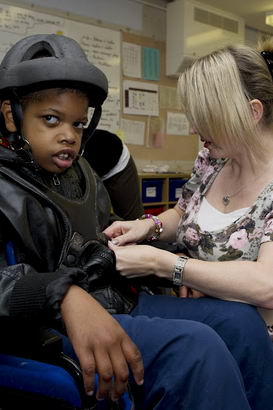
This module is concerned with the definitions of disability contained within UK legislation.
If children are disabled they have entitlements arising from their assessed needs. This section identifies 'what counts as disability' within the context of different acts of parliament.
You will have seen discussions around the use of the terms 'disabled' and 'disability'. There is ongoing debate about what is meant by these terms and how to use them in different contexts.
Section 6 of this Act states that a person is disabled if they have a disability which is defined as:
- Physical or mental impairment.
- Impairment that has a substantial and long term adverse effect on their ability to carry out normal day-to-day activities.
Where treatment or the provision of aids reduces the disabling effects of a condition that would otherwise meet the above criteria, then the impairment is still considered to have a 'substantial adverse effect'.
A child with a progressive degenerative condition meets the criteria if their condition is likely to result in a 'substantial and long term adverse effect' in the future, even if it does not currently do so.
In order to interpret this definition, it is necessary to understand the meanings of the terms used. This Act contains defined meanings for specific terms, but it should be borne in mind that these terms may have different meanings when used in other legislation.
Further discussion of the application of these definitions is available in the Equality Act 2010 Guidance.
The implications of the Equality Act 2010 for schools and services are considered
later
in this module.
Take a look at the Equality Act 2010 Guidance to find out more.
Impairment
Substantial
Long-term
Normal day-to-day activities
The Act itself does not define the term impairment and case law has established that a formal medical diagnosis is not always required, as long as it is proven that functions are impaired. However, if no organic or mental cause of symptoms can be found, it may be difficult to secure a tribunal endorsement that a person has an impairment.
The provision for a specifically described condition to be (or not to be) an impairment may be made by parliament through Regulations.
Return
The term substantial means 'more than minor or trivial' (section 212(1)). However, the cumulative effect of a number of 'minor' impairments may be considered as 'substantial'.
Where the impact of an impairment is reduced or eliminated through measures taken to correct it (eg medication, a prosthesis or other aid), the effects must be considered as if these measures were not taken. This does not apply where spectacles or contact lenses are used to correct sight.
Return
Schedule 1 (Part 1, paragraph 2(1)) of the Act states that:
The effect of an impairment is long-term if:
(a) It has lasted for at least 12 months.
(b) It is likely to last for at least 12 months.
(c) It is likely to last for the rest of the life of the person affected.
If the substantial effects of a long-term impairment cease, it is still considered as continuing if those effects are likely to recur.
Regulations may prescribe circumstances where, despite these circumstances, an effect should (or should not) be considered long-term.
For example, a severe disfigurement is deemed to have had a substantial adverse effect on the ability of the person to carry out normal day-to-day activities.
Return
These are actions that are carried out by most people on a daily basis, and there is considerable case law to assist with determining which activities are included.
The Equality and Human Rights Commission defines normal day-to-day activities as involving any of the following:
- Mobility.
- Doing something with your hands.
- Physical coordination.
- Continence (controlling your bladder and bowels).
- Ability to lift, carry or move everyday objects.
- Speech, hearing or eyesight.
- Memory or ability to concentrate, learn or understand.
- Perception of the risk of physical danger.
Return
So far in this section we have considered the applications of the Equality Act 2010, however the Children Act 1989 is also relevant as it contains a definition
of disability that is applicable within other
related legislation.
Children with disabilities are children 'in need' as defined by section 17(10(c)) of the Children Act 1989 and are entitled to a range of support services depending on their circumstances.
The definition of disability given in Part III of this Act is more medically oriented than the Equality Act 2010.
Section 17(11) of the Children Act 1989 states:
'...a child is disabled if he is blind, deaf or dumb or suffers from mental disorder of any kind or is substantially and permanently handicapped by illness, injury or congenital deformity or such other disability as may be prescribed.'

The definition within the Children Act 1989 reflects the definition that is applicable to
adults within section 29 of the National Assistance Act 1948, and is the definition that also
applies to children under the two
following Acts:
- Disabled Persons (Services, Consultation and Representation) Act 1986 (section 16).
- Chronically Sick and Disabled Persons Act 1970 (section 28a).

A record of the number of
children with SEN is listed
on the Register of Children with Disabilities. Through discussion with the school,
SENCOs find out what records
are kept by each school and what data the school has to provide to local or
national bodies.
Think of a child that you know (in or out of school) and consider whether or not they fall within the legislative definition of 'disabled'. Use the following questions to help you.
1. Does the child that you are thinking of have difficulty with any of the following 'normal day-to-day activities'?
Click here to read about the typical tasks or activities that a disabled child might have particular difficulty with.
2. Is the child's difficulty caused by an underlying impairment or condition?
3. Has the child's impairment or condition lasted, or is it likely to last, for more than 12 months?
4. Is the effect of the child's impairment or condition 'more than minor or trivial'?
If you have answered yes to questions one to four, then the child is probably disabled under the Equality Act 2010. If the child receives medical or other treatment to reduce or remove the effects of their condition, they may still be disabled. The test is whether the effects would recur if they were to stop their treatment." (the user has just been asked to think about a child, not a specific child called Tom.
Source: The previous paragraph is abridged from: DfES implementing the Disability Discrimination Act 2005 in schools and early years settings 2006.
- Mobility: getting to/from school, moving about the school and/or going on
school visits - Manual dexterity: holding a pen, pencil or book, using tools in design and technology, playing a musical instrument, throwing and catching a ball
- Physical co-ordination: washing or dressing, taking part in games and PE
- Ability to lift, carry or move everyday objects: carrying a full school bag or other fairly heavy items
- Continence: going to the toilet or controlling the need to go to the toilet
- Speech: communicating with others or understanding what others are saying; how they express themselves orally or in writing
- Hearing: hearing what people say in person or on a video, DVD, radio or
tape recording - Eyesight: ability to see clearly (with spectacles/contact lenses where necessary), including any visual presentations in the classroom
- Memory or ability to concentrate, learn or understand: work in school including reading, writing, number work or understanding information
- Perception of the risk of physical danger: inability to recognise danger eg when jumping from a height, touching hot objects or crossing roads
Return
